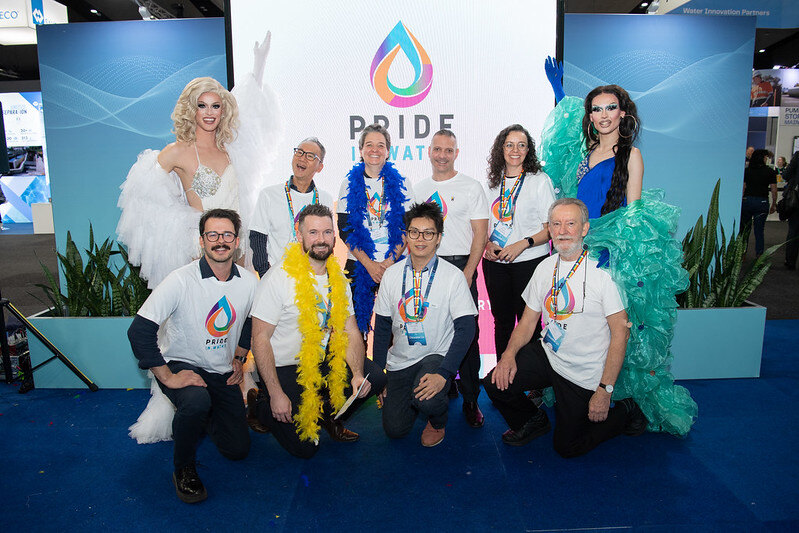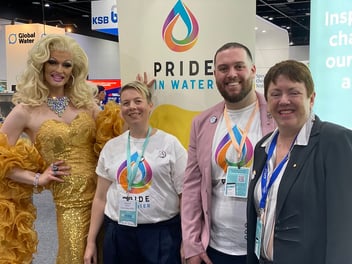Pride in Water: fostering inclusivity for the LGBTQI+ community

The Pride in Water Activation took over the Australian Water Association stand at Ozwater again this year, with the very glamorous presence of drag artists Sam T Drag and Avah Miss-Beehava.
But it wasn’t all sequins and glitter. As well as some amazing performances and dazzling outfits, the Pride in Water Activation also made space for conversations with water professionals and executives about inclusivity.
Reflecting on the event, Pride in Water’s Pat Quaine said one of the most important aspects of Pride in Water’s participation at Ozwater every year is to create an environment that is inclusive and welcoming for members of the LGBTQI+ community.
“Inviting Sam T Drag and Avah Miss-Beehava to perform at the Pride in Water Activation is a great way for us to support queer artistry. But it’s also incredibly engaging – it's fun and celebratory, and encourages people to learn about Pride in Water,” he said.
The organising committee for the Ozwater’24 Pride in Water Activation include Quaine, as well as Lorena Oliveira, Chris Lee and Lachie Glascodine, and Cam Tirendi, who was integral to sourcing and supporting the wildly colourful and exuberant drag artists.
“The Pride in Water Activation was also a fabulous show of inclusivity. By hosting drag artists at Ozwater, we are showing everybody that we can and do include everyone in this space,” Quaine said.
“But one of the key parts of the event was to engage some of our key water leaders, to ask them some questions about their commitments to inclusivity of LGBTQI+ people in the industry.
“Lots of our water leaders are doing what they can to foster more inclusivity. This year it wasn’t just about being loud and proud, it was also about asking some critical questions about creating more inclusive spaces for the LGBTQI+ community.”
Building community and inclusivity
Established in 2019 by Jacquie Moon and Brendan Moore, Pride in Water is a platform dedicated to allowing for and creating connections between LGBTQI+ people and their allies in the water sector.
“The vision of Pride in Water has always been to help create a water sector where LGBTQI+ people feel welcome, included and feel like they can bring their full selves to work,” Quaine said.
“Primarily, Pride in Water is about fostering connection for the LGBTQI+ community. Being a national group is important in this regard, it allows us to reach people that might not have that connection within their organisation.
“This is needed the most out in the regions, where people are working for smaller organisations and there are less queer-identifying people. So Pride in Water is also about creating opportunities for people to connect across bigger distances.”
Quaine said it’s crucial to make space for LGBTQI+ diversity within the water sector, which historically has been a male-dominated and heteronormative industry.
“For a long time, people have been very cautious about coming out at work. The aim has always been to help break down the barriers,” he said.
“Our society has come a long way. Some of us are lucky enough not to have experienced blatant discrimination, a mark of all the work that people before us have done.
“But it doesn’t necessarily take blatant discrimination to feel unwelcome or that we need to hide certain parts of ourselves. The Pride in Water community is all about standing for a future where everyone feels welcome and supported.”
Guiding industry
As far as the water sector has come in terms of working towards creating more inclusive workspaces, there’s still more work to do, which is why Pride in Water is also focused on supporting the sector in its inclusion journey.
“Aside from creating a safe space for the LGBTQI+ community within the water sector, Pride in Water also aims to provide support to the industry about what they can do to build more inclusiveness,” Quaine said.
“Pride in Water’s most strategic objective is to allow people with lived experience to independently talk to the sector, so that people can say what needs to be said without fear. It’s a way for us to advise industry, while remaining independent.”
While the Pride in Water network has been around for five years now, Quaine said more recently the organisation has been focused on stabilising its governance structure and offerings.
“We have had many organisations across the sector come to us to ask how they can support Pride in Water to make it a sustainable platform. That’s really exciting,” he said.
“We’ve been a bit quiet on the public front, but we have been working really hard behind the scenes to create a sustainable model for organisations that want to support us.
“Pride in Water has been reliant on people volunteering their time and skills to do a lot of the work. A lot of our employers have been supportive of us using time during work to do some of this work.
“But generally, much of this work occurs outside of work hours. It’s a lot to expect people to volunteer their spare time to make all of the change happen. It leads to burnout, which results in a disconnect in the network.”
Supporting Pride
In the past 12 months, Pride in Water participated in the Pride March as part of the Midsumma Festival in Melbourne in February, and also had a presence at the Connected by Water Conference in Perth.
Pride in Water is looking forward to hosting more social events soon, Quaine said, but is currently focused on establishing a sustainable model of engagement for the broader water sector to support the platform.
“Our goal is to bring on a network facilitator to help our advisory committee to reduce the voluntary workload of the group. This will help create and market events, or to help LGBTQI+ people in the water sector to facilitate their own events,” he said.
“We’d love to see more in-person events around the country. But we will have a better ability to run those events when we have investment.
“One of the most amazing things about the water sector is the support it is showing for people with lived experience who want to speak up about how change can be made to help people feel more included.
“It’s really amazing to see the industry support people being proactive in that space. Some organisations are showing a lot of interest in supporting us in this way, and so we have a strong focus now on ensuring we can receive that support and utilise it effectively.”
How can water organisations support Pride in Water? Quaine said allowing employees the time needed to participate in events is a great start, but supporting the network by investing in its longevity is also really important.
“If an organisation really wants to show their support for Pride in Water, they can encourage participation in our events. But it’s important for us to put our money where our mouth is if the initiative is to become sustainable,” he said.
“Supporting the LGBTQI+ community to do this work all starts by reaching out. In turn, we expect to have our new engagement model established later this year.
“We always want to have more people involved. We welcome anybody with lived experience to reach out and join us in our work. And for organisations that want to be allies, register your interest with us so that we can communicate our model with you.”
Interested in supporting Pride in Water? Express your interest by reaching out to Dale Watson (dale.watson@wsaa.asn.au) from WSAA who can connect you with the group.


